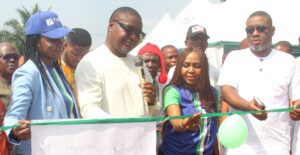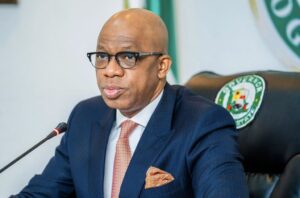Ogun Press Centre: Segun Osoba’s homage to homecoming
By Kayode Akinmade
It is a no-brainer that homecoming is a crucial phenomenon in human life. Home is where the roots lie; it is the stream from which energy and creativity sally forth. And this is why, for instance, literature as a potent vehicle of human expression has often engaged the multi-faceted wavelengths of homecoming. Whether you are talking of Thomas Hardy’s The Return of the Native, a cliffhanger dissecting home and pain; Margaret Atwood’s The Penelopiad, a Grecian rendition where Odysseus ultimately returns from his travels, Hassen Khemiri’s The Family Clause with its drama of a grandfather returning to his family in Sweden, or Julian Barnes’ Love, a marital drama about the aftermath of heartbreak and the dynamics of returning ex-husbands, the idea of homecoming inhabits literature as a sold strand. As the literary critic Benedict Ibitokun shows in his epochal inaugural, “Literature and quest for the roots,” all of literature hankers back to the source: African literature cannot but engage the theme of Beginning, of the past and its intricate relation to the present and the future.
One homecoming in Abeokuta, few days ago, offers rich material for our creative and critical lore. On Tuesday, May 25, celebrated journalist and former governor of Ogun State, Chief Segun Osoba, returned to the grounds of the Government Secretariat, Abeokuta, in a blaze of glory. An outsider for a decade and a half, the reporter’s reporter exuded ecstasy as the newly-minted Olusegun Osoba Press Centre at Oke Mosan, a majestic edifice was commissioned by Governor Dapo Abiodun. Osoba had once ruled on these grounds, the first time during a brief stay as a Social Democratic Party (SDP) governor between 1992 and 1993, and the second as an Alliance for Democracy governor (1999 – 2003), but politics had made him a pariah for many seasons. And so the 82-year-old, arguably a media man for all seasons, paid his homage to homecoming, and to the resilience of a new democratic order in the Gateway State. It was such a beauty, such a joy to behold.
The words deserved to be etched in marble: “To imagine that in my life, my return to these premises will be this glorious is something of emotion. I couldn’t come to Abeokuta, not to talk of visiting the office of the Governor. Mr. Governor, you will not know how many hours you have added to my life with this action today. It may be hours, weeks, days, or years, but you have added something very great to my life today.”
You cannot begrudge Osoba his homage to homecoming. The May 25 event was, as The Nation’s editorial poignantly observed, indeed one of a great return to the roots. After a 15-year hiatus, he was honoured in the same secretariat where he had been declared persona non-grata, a reward for his labour of many decades.
The event, though, was one bit of paradox: it was the first time a Press Centre was being commissioned since 1976 when the state was created. As the public is no doubt fully aware, before now, the site where the press held court was the Nigeria Union of Journalists (NUJ) Press Centre at Oke-Ilewo, opposite the old secretariat. Given Ogun State’s place as the vanguard of press presence and the bastion of freedom of expression in Nigeria—Nigeria’s very first paper, the Iwe Iroyin, began operations in Abeokuta in 1859—it is something to regret that a government-built Press Centre took so long in transit. Happily, though, the lacuna has been plugged, and members of the Fourth Estate of the Realm can now begin the anew.
The Press Centre comes very well recommended: it boasts two press halls and an arena fitted with work tools where journalists would be doing their jobs. The governor’s CPS has a modern office there and the governor has a waiting bay where he can stay until the press is ready for his address; a canteen, rest rooms, etc. It is a press centre that can favourably compare with any other in the country.
It is a tribute to Abiodun’s genius that in naming the Ogun Press Centre, he chose a worthy citizen whose journalistic legacy is, quite simply, beyond reproach.
The two-time governor, ex managing editor of Daily Times, Sketch and Herald newspapers has his name implanted in gold. Osoba it was, who, as a Daily Times correspondent, discovered the bullet-ridden body of Prime Minister Tafawa Balewa in January 1966. During the Nigerian civil war, he risked life and limb to inform the public.
He was reputed as the only reporter of his time who had a telephone at home, Osoba broke stories at will. As Reuben Abati notes: “Reporter, sub-editor, deputy editor, editor, General Manager, Managing Director from Daily Times to The Herald, to The Sketch newspaper and back to The Daily Times in 1984, Osoba’s story is well told in his autobiography, Battlelines: Adventures in Journalism and Politics which, in my view, is a must-read. Osoba, first Nieman Fellow in Journalism from Nigeria, is highly revered, deservedly.”
And not even the passage of time has dulled his journalistic energy: Osoba was at the recent Guild of Editors meeting in Kano, to give wise counsel and support to the emergence of a new executive. He was with the Editors from 30 May to 2 June 2021. And when it was time for project inspection on Tuesday 2 June, Osoba was with them from 9.00 am till 7.00 pm. They were led by Governor Abdullahi Umar Ganduje on an inspection tour of some projects executed by his administration. They inspected the multi-billion naira Ultra-Modern Cancer Centre, Aminu Alhassan Dantata flyover along Murtala Muhammad Way, Tijjani Hashim flyover at Kofar Ruwa, Madobi Challawa flyover, Sheikh Qariballah Nasiru Kabara flyover at Shahuci, Ultra-Modern Three-layer Dangi flyover and Kwari market flyover, among others.
During the inspection tour, a recently completed Yahaya Gusau Road (which links the main Bayero University Kano road to Sharada industrial area road) in the metropolis was, as a great honour, commissioned by Chief Segun Osoba.
At the Gala Night organized for the editors by Kano State Government, Ganduje praised Osoba who “at 82 stayed with us throughout the inspection tour.”
In fact, there is nothing the Guild organizes that Osoba would not be present to show support. As an elder, he applies his judgment the way hot knife would cut through butter when he mediates in conflicts among these media “gate keepers.” What is gratifying is that they defer to him; they bow to his interventions and verdicts.
On personal levels, Osoba does not fail to tell “my colleagues” ( he does not look down on any journalist) on the need to plan for the future by way of investments, especially real estate. This is because just as the editor’s seat is not permanent, every day is not Christmas! That is why all journalists love Osoba. Yes, they do.
Apparently, when Governor Abiodun came into office, he discovered a missing link in the Ogun governance: the media had not been placed in its rightful position. Apprised of the fact that in order to bring government closer to the people, his administration had to take appropriate advantage of the media and its resources, he went straight into action. Promise made, promise kept. If the history of politicking in Nigeria is anything to go by, the Ogun monument is quite significant. Some governors are always afraid of their shadows: they fight tooth and nail to keep the prying eyes of the media off their doings, apparently because those doings are evil. They know that honest reportage of their activities will generate public resentment in their direction, so they offer little or no information and keep the people away from the stream of information. Ogun State’s Abiodun, a governor who, we learn by the day, is always quite clinical in thinking and ebullient in the implementation of democratic dividends, away from the madding crowd of non-performers, apparently has nothing to hide. He knows the place of Abeokuta and Ogun State in media history. He knows that the pull of journalism in the ancient city is irresistible: he knows that many media giants hailed/still hail from this great land: the strides of Prof. Shobowale, Najim Jimoh, Demola Osunnubi, Chief Tola Adeniyi, Late Gbolabo Ogunsanwo, Onanuga, Reuben Abati, the late Chief Bisi Onabanjo (Ayekooto), Niran Malaolu, Tokunbo Oloruntola, Yemisi Fadairo, Lekan Otufodunrin, and of course Osoba himself bear eloquent testimony to the fact.
We must not depart from the theme of transparency. Governor Abiodun is apparently very transparent and that is why he has chosen to bring the media close to his office. Freedom of expression and freedom of the press are vital to democratic sustenance. Ensuring that that the media does its job in a conducive environment is something deserving of accolades.
Akinmade, former Commissioner of Information in Ondo State, contributes this piece from C27 Winning Clause Estate, Gwarimpa, Abuja.




